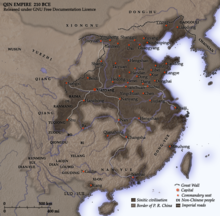
Back Crema de llibres i enterrament d'intel·lectuals Catalan Die Bücherverbrennung und das Begraben von Gelehrten bei lebendigem Leibe German Quema de libros y sepultura de intelectuales Spanish Incendie des livres et enterrement des lettrés French ग्रंथो को जलवाना और विद्वानों को दफनाना Hindi Könyvégetés és a tudósok eltemettetése Hungarian Pembakaran buku dan penguburan cendekiawan ID Rogo di libri e la sepoltura di studiosi Italian 焚書坑儒 Japanese 분서갱유 Korean
 Qin region Outlying regions |
| Burning of books and burying of scholars | |||||||||||||||||||||||||||||||
|---|---|---|---|---|---|---|---|---|---|---|---|---|---|---|---|---|---|---|---|---|---|---|---|---|---|---|---|---|---|---|---|
| Traditional Chinese | 焚書坑儒 | ||||||||||||||||||||||||||||||
| Simplified Chinese | 焚书坑儒 | ||||||||||||||||||||||||||||||
| Literal meaning | burning books and burying scholars | ||||||||||||||||||||||||||||||
| |||||||||||||||||||||||||||||||
The burning of books and burying of scholars was the purported burning of texts in 213 BCE and live burial of 460 Confucian scholars in 212 BCE ordered by Chinese emperor Qin Shi Huang. The events were alleged to have destroyed philosophical treatises of the Hundred Schools of Thought, with the goal of strengthening the official Qin governing philosophy of Legalism.
Modern historians doubt the details of the story, which first appeared more than a century later in the Han dynasty official Sima Qian's Records of the Grand Historian. As a court scholar, Sima had every reason to denigrate the earlier emperor to flatter his own, but later Confucians did not question the story. According to the historian Ulrich Neininger, their message was, "If you take our life, Heaven will take the life of your dynasty."[1]
Modern scholars agree that Qin Shi Huang gathered and destroyed many works that he regarded as incorrect or subversive. He ordered two copies of each text to be preserved in imperial libraries. Some were destroyed in the fighting following the fall of the dynasty. He had scholars killed, but not by being buried alive, and the victims were not rú (Chinese: 儒; lit. 'Confucians'), since that school had not yet been formed as such.[2][3][4]
- ^ Neininger (1983), p. 122.
- ^ Goldin (2005), p. 151.
- ^ Nylan (2001), pp. 29–30.
- ^ Kern (2010), pp. 111–112.